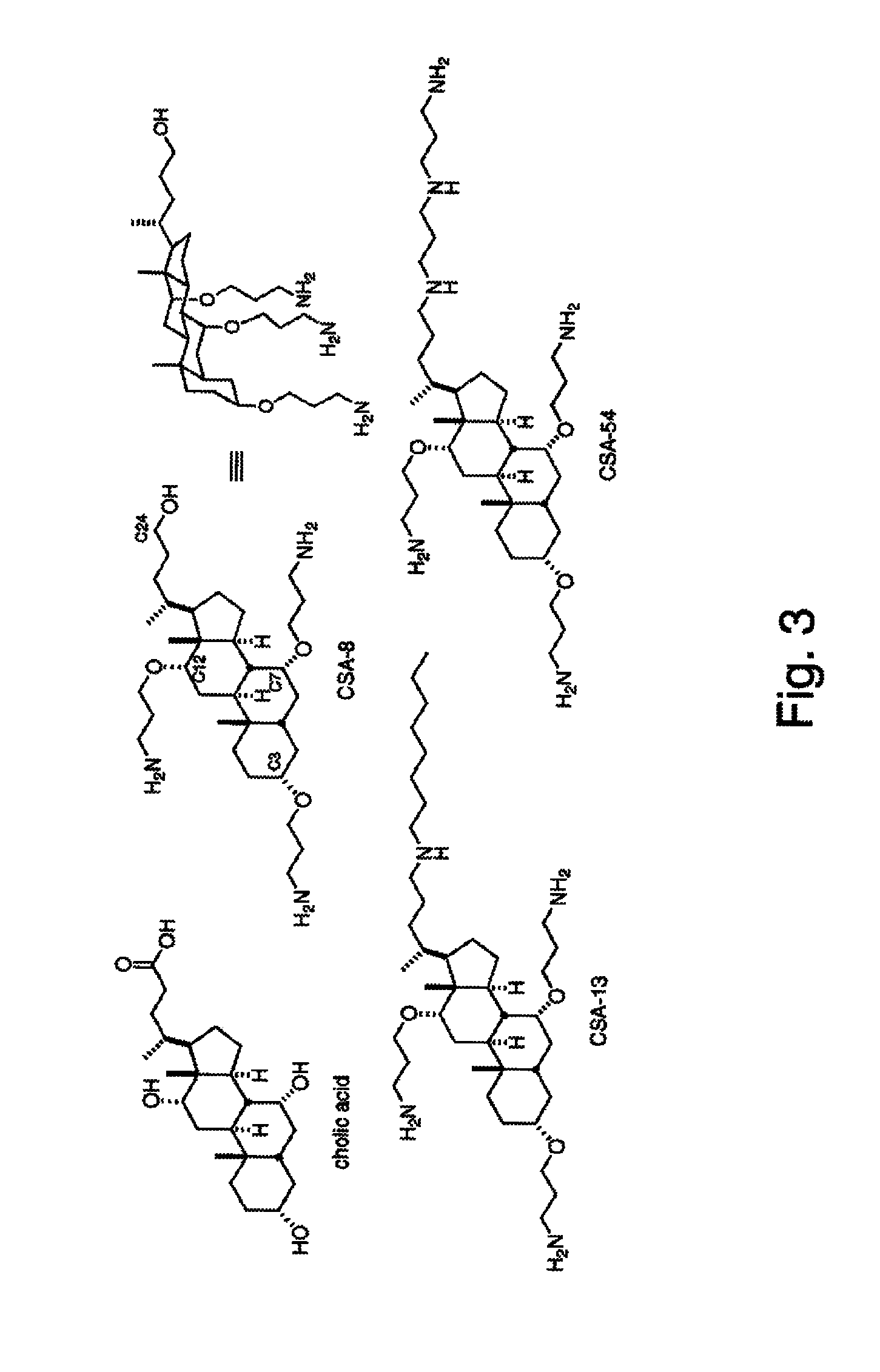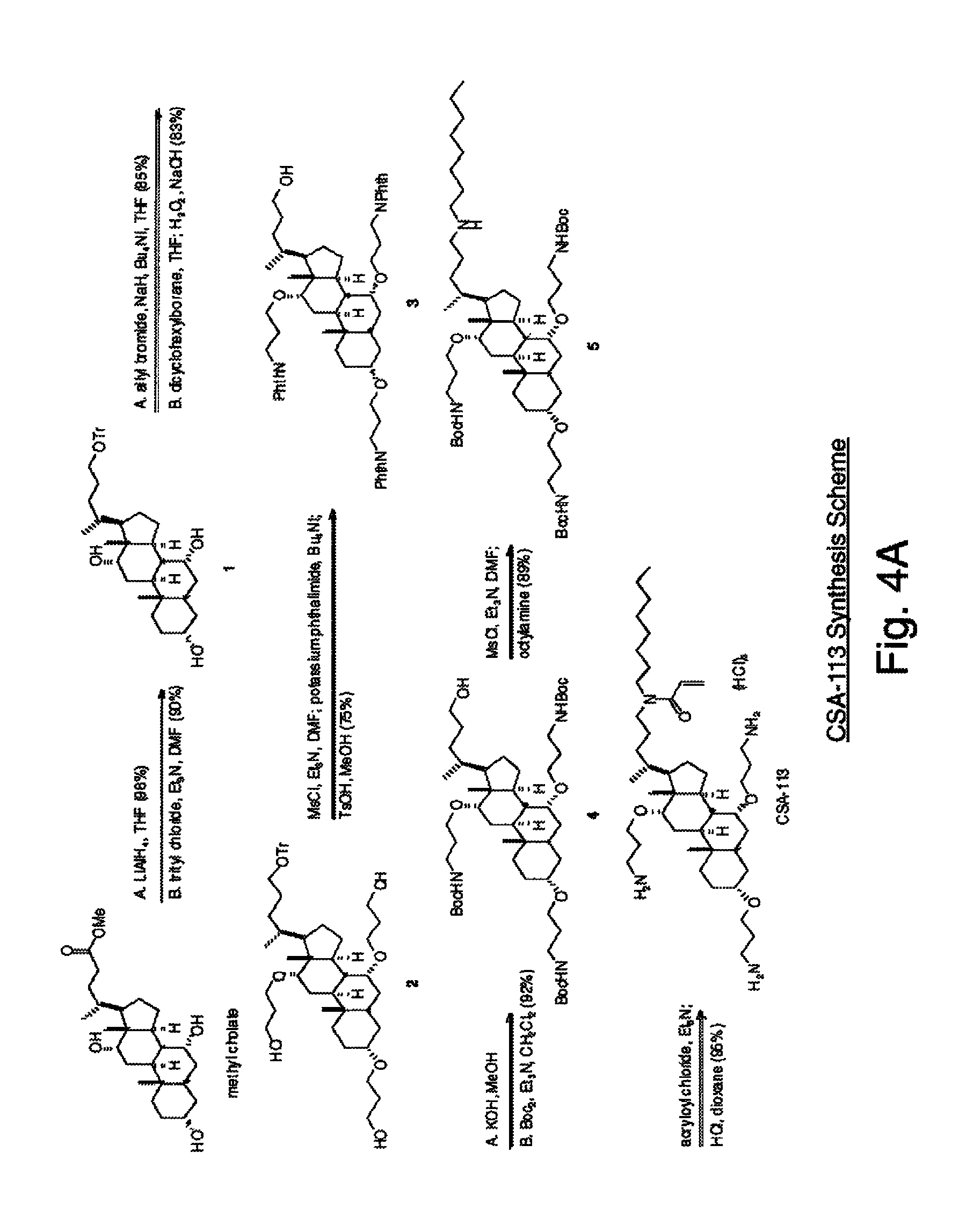Biofouling-resistant ceragenin-modified materials and structures for water treatment
- Summary
- Abstract
- Description
- Claims
- Application Information
AI Technical Summary
Benefits of technology
Problems solved by technology
Method used
Image
Examples
example 1
[0074]Example 1 illustrates an example of using Attachment Scheme-III to attach ceragenins to a polyamide membrane. A 2″×4″ piece of polyamide RO membrane was pretreated by soaking in a 5% solution of sodium bicarbonate (aqueous) for 1-2 hours. Then it was rinsed with water, dipped briefly into isopropyl alcohol (IPA) and then the surface was treated with 800 mg of 3,4-epoxy-1-butene dissolved in 32 mL of IPA. During this treatment, the membrane and solution were heated to 45° C. for 15 minutes. The membrane was rinsed with IPA and then water. The surface of the membrane was then treated with a solution of CSA-113 (224 mg), acrylamide (19 mg) in 26.67 mL water. The initiator (0.83 mg potassium persulfate+0.28 mg sodium metabisulfite) was added and the reaction was allowed to take place at room temperature for 24 hours. Finally, the membrane was rinsed with water.
[0075]
[0076]The amine-linking method of Scheme-III was also tried using a combination of CSA-109+acrylic acid, but the pre...
example 2
[0089]Example 2 illustrates an example of using Attachment Scheme-IV to attach ceragenins to a polyamide membrane. A 1″×3″ piece of polyamide RO membrane was pretreated by soaking in deionized water for 24 hours and then in ethanol for 5-10 minutes. Then it was soaked in a 10 mM solution of benzophenone in ethanol at room temperature for 1 hour, after which it was removed and dried under vacuum. Next the surface of the membrane was covered with an aqueous solution of CSA-113 (337 mg) and acrylamide (28 mg) in 8 mL water. The membrane and solution were covered with a quartz plate, and UV radiation (365 nm) was directed through the quartz plate for 30 minutes. Finally, the membrane was rinsed with water.
Attachment Scheme-V
[0090]Attachment scheme-V (also referred to as the “silane-coating method”) can be used on any polymer substrate; and in particular on spacers or membranes (although an initial plasma treatment can damage ultra-thin polyamide membranes). In scheme-V, a very thin, sil...
example 3
[0120]Example 3 illustrates a first example of using Attachment Scheme-V to attach ceragenins to a Vexar® spacer. A 1.5″×3.5″ piece of Vexar® (LDPE) spacer was pre-treated with an argon / oxygen plasma for 2 minutes. The spacer was exposed to air for about 10 minutes and was then immersed in a 2% solution of 3-aminopropyltrimethoxysilane (APTMOS) in toluene for 90 minutes at room temperature. After rinsing with toluene and then with ethanol, the spacer was immersed in a 1.5 wt. % solution of CMBC (or alternatively, acryloyl chloride) in dichloromethane. The reaction was heated to reflux temperature for 20 minutes. The spacer was then washed with dichloromethane and dried in air at room temperature. The spacer was then dipped into a solution of CSA-113 (1.22 g) and acrylamide (0.094 g) in a water:methanol (1:1, 20 mL, degassed). After removing it from the monomer solution (without rinsing or washing), the spacer was placed under a UV lamp (365 nm) for 15 minutes. Then it was turned ove...
PUM
| Property | Measurement | Unit |
|---|---|---|
| Electrical resistance | aaaaa | aaaaa |
Abstract
Description
Claims
Application Information
 Login to View More
Login to View More - R&D
- Intellectual Property
- Life Sciences
- Materials
- Tech Scout
- Unparalleled Data Quality
- Higher Quality Content
- 60% Fewer Hallucinations
Browse by: Latest US Patents, China's latest patents, Technical Efficacy Thesaurus, Application Domain, Technology Topic, Popular Technical Reports.
© 2025 PatSnap. All rights reserved.Legal|Privacy policy|Modern Slavery Act Transparency Statement|Sitemap|About US| Contact US: help@patsnap.com



